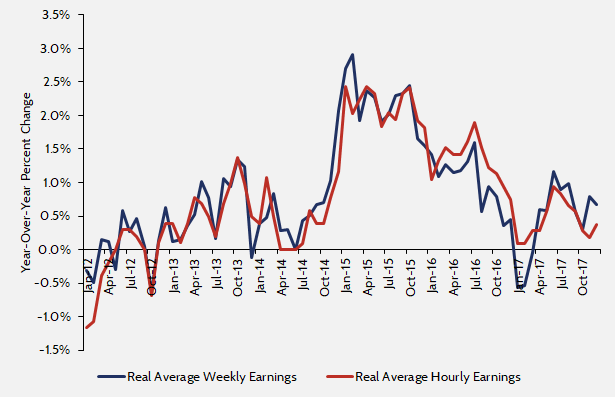Insight
February 1, 2018
Wage Growth in the Past Six Years
During the State of the Union address, President Trump celebrated labor market growth in the U.S. economy by highlighting worker wages: “After years of wage stagnation, we are finally seeing rising wages.”[1] In recent years, the labor market has experienced steady job growth and a declining unemployment rate. Yet, wage growth has been sluggish. So, did wages finally begin to grow in 2017? Data from the Bureau of Labor Statistics (BLS) provide insight into this issue.
The chart below contains year-over-year changes in real (inflation-adjusted) hourly earnings and real weekly earnings in the private sector since 2012.
Year-Over-Year Change in Private Sector Real Hourly and Weekly Earnings, 2012-2017[2]
Despite briefly accelerating in 2015, wage growth has been tepid in recent years and 2017 was no different. Since 2012, real average hourly earnings have only grown at a 0.8 percent average annual rate. From 2012 to 2014, wages grew particularly slowly, averaging an annual growth rate of only 0.4 percent.
Wage growth did strengthen at the end of 2014 and through 2015. In particular, real average hourly earnings grew over 2 percent in 2015. The heightened wage growth, however, was relatively short lived. By 2016, wage growth began to taper off quickly. And in 2017, real wages on average grew at a 0.4 percent annual rate, returning to the average annual growth rate experienced from 2012 to 2014.
Meanwhile, growth in real average weekly earnings mirrored growth in average hourly earnings. Weekly earnings incorporate both hourly wage rates and weekly hours at work, providing a more wholistic view of average earnings. The fact that real average weekly earnings tracked real wages suggests that hours remained stagnant throughout the past six years as well. Consequently, the harm of slow wage growth has not been abated by increased hours of work.
While unemployment has fallen and jobs continue to grow, BLS wage data indicate there is still much room for improvement in the labor market.
[1] “State of the Union 2018: Read the full transcript,” CNN, January 31, 2018, https://www.cnn.com/2018/01/30/politics/2018-state-of-the-union-transcript/index.html.
[2] Current Employment Statistics, Bureau of Labor Statistics, https://www.bls.gov/data/.











